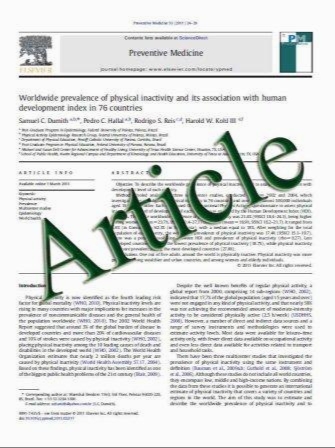Dehydroepiandrosterone-Sulfate Modifies Human Fatty Acid Composition of Different Adipose Tissue Depots
- نوع فایل : کتاب
- زبان : انگلیسی
- مؤلف : Juan Jose Hernandez-Morante & David Cerezo & Rosa Maria Cruz & Elvira Larque & Salvador Zamora & Marta Garaulet
- چاپ و سال / کشور: 2010
Description
Background Dehydroepiandrosterone-sulfate (DHEA-S) has been described as a protector agent against obesityrelated pathologies, although the mechanism of action is still unknown. We have shown that DHEA-S acts on adipose tissue (AT), altering the fatty acid (FA) profile in rodents. Thus, we could hypothesize that some of the beneficial effects shown by DHEA-S in humans are related to a modification of the human AT-FA profile. The present study examines this question and whether this effect is tissue-dependent. Methods Paired visceral and subcutaneous AT biopsies were obtained from 20 patients who had undergone bariatric surgery. These samples were subjected to primary adipose culture and incubated for 24 h with 1 ىM DHEA-S. The FA profile of both control and treated samples were analyzed by gas chromatography. Results A reduction in total saturated fatty acids (SFA), the n.6 family of polyunsaturated fatty acids (PUFA) and the n.6/n.3 PUFA ratio was observed after DHEA-S treatment, whereas monounsaturated fatty acids (MUFA) increased. In addition, DHEA-S altered the percentage of several individual FA, decreasing palmitic acid and increasing vaccenic acid in both AT. All estimated desaturase activity ratios slightly increased after DHEA-S treatment, although only the increase of delta-6-desaturase index in both depots reached statistical significance. No depotspecific action of DHEA-S was found between subcutaneous and visceral AT. Conclusions In vitro, DHEA-S modifies the AT-FA composition towards a better metabolic profile to a similar extent in the subcutaneous and visceral adipose depots, in both of which a decrease in SFA and increased MUFA are observed after treatment. This effect could help to explain the beneficial effects attributed to DHEA-S. Further studies, however, are required to determine whether the effect of DHEA-S on adipose tissue in vitro is conserved in vivo.
OBES SURG (2011) 21:102–111 DOI 10.1007/s11695-009-0064-8 Received: 30 July 2009 / Accepted: 15 December 2009 / Published online: 22 January 2010


